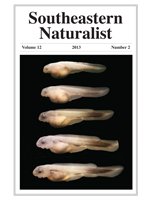We sampled ground beetles (Coleoptera: Family Carabidae) at the Furman Forest in northeast Greenville County, SC, and compared species richness and community attributes with tree stand richness, diversity, and composition. Beetles were collected by pitfall trap 1 night/week for 9 weeks from June to August 2011 in 24 plots (200 m2) varying in tree abundance (11–131 trees/plot), mean tree size (6.5–26.0 cm DBH), species richness (2–13 species/plot), Simpson's diversity (1.6–9.1/plot), and composition. We collected 286 carabids representing 13 genera and 26 species, including a new state record for South Carolina, Cyclotrachelus hypherpiformis. Carabid abundance, species richness, and diversity were unrelated to tree abundance, richness, or diversity. However, carabid abundance and richness were positively correlated with the abundance of Liriodendron tulipifiera (Tulip Poplar), suggesting a preference for mesic habitats. Total carabid abundance and the abundance and dominance of Carabus goryi (the most abundant species) were also positively correlated with mean tree size (DBH), suggesting a preference for older stands. Carabid diversity, abundance, and community structure were associated with habitat type and stand age (as indicated by dominant canopy species and tree size) and not canopy tree species richness or diversity.
How to translate text using browser tools
1 June 2013
Relationships between Carabid Beetle Communities and Forest Stand Parameters: Taxon Congruence or Habitat Association?
Wade B. Worthen,
David C.G. Merriman
ACCESS THE FULL ARTICLE

Southeastern Naturalist
Vol. 12 • No. 2
June 2013
Vol. 12 • No. 2
June 2013




